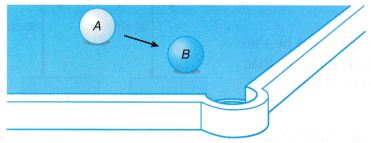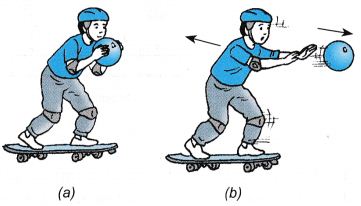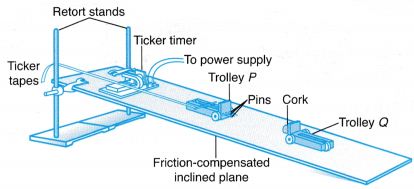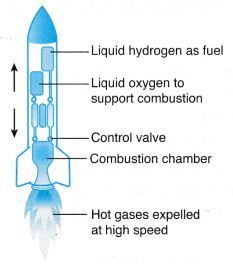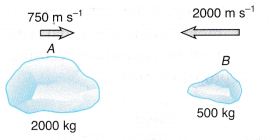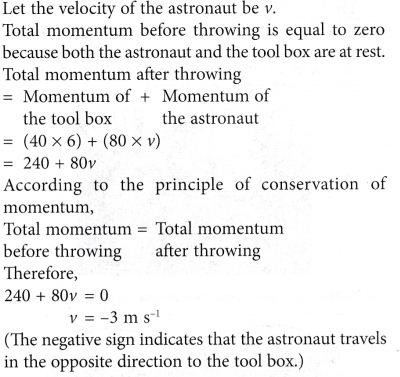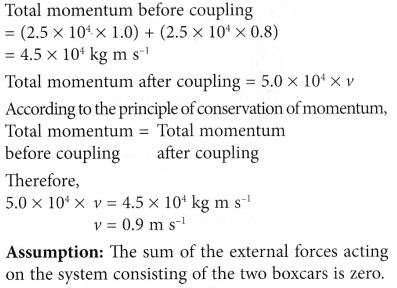Newton’s Laws Of Motion
(A) Newton’s First Law of Motion
A body can not change its state of motion by itself. If the object is at rest it will remain at rest and if it is in uniform motion, it continues to be in motion unless some external force is applied on it.
- Newton’s First Law of Motion states that if there is no net force acting on a body, its state of motion will be unchanged.
- If the body is at rest, it will remain at rest. If the body is moving, it keeps on moving at a constant speed in a straight line.
- Newton’s first law is sometimes called the Law of Inertia.
- The object is not necessarily at rest. The object may be moving at constant speed in a straight line.
- To remember Newton’s First Law of Motion
When F = 0 (No resultant force)


Inertia:
There is an inherent property of an object by virtue of which it cannot change its state of motion or rest by itself. This property is called ‘inertia’.
Inertia is of two types– inertia of rest and inertia of motion.
(a) Inertia of rest: If the body is at rest, it will continue to be at rest unless some external force is applied on it. Examples are following.
Examples:
1. When a train at rest starts moving suddenly, a passenger standing inside the compartment tends to fall backward.
2. When a carpet is beaten up with a stick, the dust particles are detached.
3. When a bullet is fired into a glass pane, it pierces a hole only at the pt where the bullet hits the glass without breaking the entire glass pane into pieces.
(b) Inertia of motion: When a body is in uniform motion, it will continue to remain in its uniform motion, i.e. it resists any change in its state of motion due to inertia of motion.
Examples:
1. when a person jumps out of a moving bus, he should run in the direction in which bus is moving otherwise he will fall down.
2. A train moving with a uniform speed and if a ball is thrown upwards inside the train by a passenger, then the ball comes back to his hand.
Situations involving inertia
The inertia of an object is the tendency of the object to remain at rest or, if moving, to continue its uniform motion in a straight line.
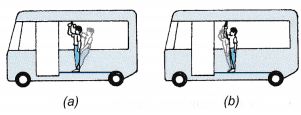 | The inertia of an object is the tendency of the object to remain at rest or, if moving, to continue its uniform motion in a straight line. In Figure (a), when the bus moves forward suddenly, the feet of the passenger are made to move forward. The inertia of his body tends to remain at rest. Hence, the passenger falls backward. In Figure (b), when the bus slows down suddenly, the feet of the passenger are brought to rest. The inertia of his body tends to continue moving forward. Hence, the passenger falls forward. |
 | A 50 cent coin is placed on a cardboard covering the top of a glass. After the cardboard is pulled quickly, the 50 cent coin hovers over the top of the glass for an instant before dropping into the glass. The coin hovers for an instant because of its inertia. |
 | When a book placed in the middle of a stack of books is pulled out horizontally with a quick jerk, the books above it tend to stay at rest due to inertia. |
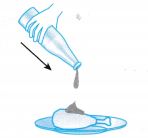 | When very little tomato sauce is left in the bottle, the bottle is given a quick downward jerk to force the sauce out of the bottle. When the bottle moves, the sauce in it moves together. When the bottle is stopped suddenly, the inertia of the sauce keeps it moving downward and out of the bottle. |
 | Figure shows a driver crashing his car without wearing a safety belt. Both the driver and the car were travelling at a very high speed. When the car was stopped suddenly, the inertia of the driver caused him to be thrown forward, thus injuring himself. |
Relationship between Inertia and Mass:
Larger the mass of the body, larger is the inertia.
Example: It is more difficult to stop a cricket ball than a tennis ball.
- The mass of an object is the amount of matter in it. The SI unit for mass is kilogram (kg). Mass is a scalar quantity.
- One kilogram is define’d to be the mass of a standard cylinder of a platinum-iridium alloy kept at the International Bureau of Weights and Measures in Sevres, France.
Inertia and Mass
- It is more difficult to move a lorry than a bicycle when both are initially at rest.
- When both are moving, it is also more difficult to stop the lorry than the bicycle.
- Hence, in comparison, the lorry has a greater tendency to be at rest than the bicycle. Likewise, the lorry has a greater tendency to continue to be in motion than the bicycle.
- The lorry has more inertia than the bicycle. The lorry has a bigger mass than the bicycle. Hence, quantitatively, the inertia of an object is measured by its mass.
Effects of Inertia
- Stick
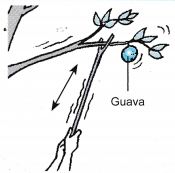
A stick is used to jerk the branch of a guava tree. At the end of the branch, there is a big guava. The guava tends to remain in its original state of rest due to its inertia. This will cause its stalk to snap and the guava will fall to the ground. - Tissue Paper

When a sheet of tissue paper is pulled quickly from a tissue box, the box will not move. The inertia of the box causes it to resist motion and remain at rest. - Blade of a Hoe
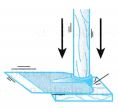

The blade of a hoe can be fitted tightly to its wooden handle by hitting the end of the handle against a hard surface as shown in the figure. The mass of the blade of the hoe is big and its inertia causes it to continue moving although the handle has been stopped, thus fitting it tighter to the handle. Likewise, the head of a hammer can be fitted into its handle this way too. - Ice Skater

After an initial push, an ice skater glides almost effortlessly on an icy surface because of inertia. - Safety Belt
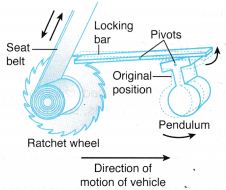
- The mechanism in a safety belt allows the belt to unwind freely when pulled gently. The mechanism consists of a ratchet wheel, a locking bar and a pendulum.
- When the vehicle is at rest or moving with a uniform velocity, the pendulum hangs straight down with the locking bar resting horizontally on it.
- When the vehicle is slowed down suddenly as in the case of an accident, the pendulum which has a big mass keeps moving forward due to its inertia. As a result, the pendulum swings on its pivot and causes the locking bar to block the rotation of the ratchet wheel and thus preventing the safety belt from unwinding.
- Ship
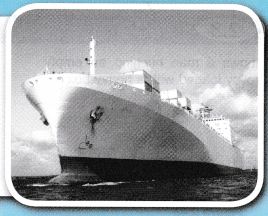
Due to its very large mass, a ship has a very large inertia. It cannot be stopped guickly even during an emergency. A very strict navigation system is needed to guide a ship when reaching a port, sailing near rocks and icebergs as well as in busy sea routes like the Straits of Malacca to prevent accidents from happening. - Rear-end Collision
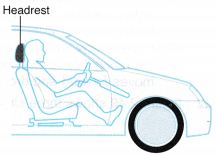
When a rear-end collision occurs, the car and the body of the driver move forward suddenly. The headrest supports the head of the driver when it is thrown backward. - Aeroplane

An aeroplane has a large mass. It cannot be stopped easily when it lands at airports due to its large inertia. Therefore, a very long runway is required for the aeroplane to stop safely. - Lorry

A steel structure is fitted in the space between the driver and the load of a timber lorry. This steel structure prevents any log from moving forward and knocking against the driver compartment when the lorry stops suddenly. - Car
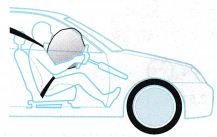
When a car stops suddenly during an accident, the driver continues to move forward because of inertia. The safety belt and airbag prevent the driver from crashing into the windscreen and injuring himself.
Experiment 1
Aim: To investigate the relationship between inertia and mass.
Problem: What is the relationship between inertia and mass?
Hypothesis: The inertia of a body increases when its mass increases.
Variables:
(a) Manipulated variable: Mass
(b) Responding variable: Inertia
(c) Fixed variable: Type of hacksaw blade (The same blade is used throughout the experiment)
Operational Definition: Period of oscillation is an indicator for inertia, the responding variable. The bigger the period of oscillation, the bigger is the inertia.
Material: Plasticine
Apparatus: Hacksaw blade, G-clamp, stopwatch
Method:
- A hacksaw blade is clamped with a G-clamp to the leg of a table as shown in Figure 2.46.
- A lump of plasticine with a mass of 30 g is attached to the free end of the hacksaw blade.
- The hacksaw blade is displaced sideways slightly and released so that it would oscillate horizontally.
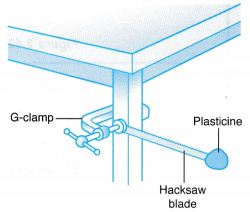
- The time taken for 10 complete oscillations, t1 is determined using a stopwatch and recorded. This step is repeated for another reading, t2.
- Steps 3 and 4 are repeated with mass of plasticine, m = 40 g, 50 g, 60 g and 70 g.
- The readings of t1 and t2 are recorded in Table.
Results:
1. Tabulation of results.
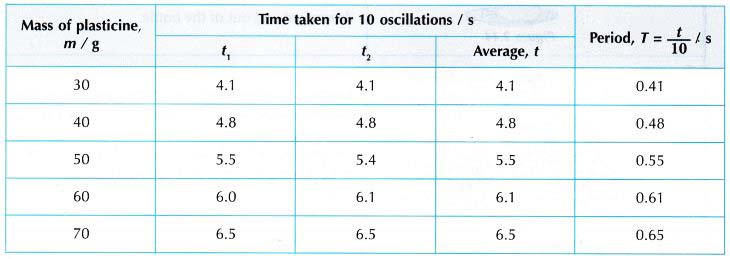
2. Graph of period, T against mass m.

Discussion:
- From the experiment, we observed that a larger mass of plasticine attached to the hacksaw blade increases the period of oscillation.
- The period of oscillation is an indicator of the inertia of the plasticine whereby the bigger the period of oscillation, the bigger is the inertia of the plasticine. Hence, the bigger is the mass of the plasticine, the bigger is its inertia.
Conclusion:
When the mass of a body increases, the body becomes more reluctant to change its state of rest or motion. This means that the inertia of a body increases when its mass increases.
(B) Newton’s Second Law of Motion
We know that,
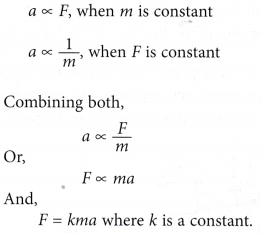
By defining 1 newton (N) as the unit force that causes an object with a mass of 1 kg to accelerate 1 m s-2 and substituting into the equation,
1 = k (1) (1)
Therefore, k = 1
With this,
F = ma
Newton’s Second Law of Motion describes the relationship between the acceleration of an object and the force applied to it.
Newton’s second law states “the rate of change of momentum of a body is directly proportional to force and takes place in the direction of force.”
i.e., when a net external force acts on an object, the acceleration of the object is directly proportional to the net force and has a magnitude that is inversely proportional to its mass.
- \(\text{ }F=\frac{{{P}_{2}}-{{P}_{1}}}{t}\text{ or }F=\left( \frac{v-u}{t} \right)=m\overset{\to }{\mathop{a}}\)
where p1 = initial momentum = mu
p2 = final momentum = mv - Unit of force in SI system is newton.
- 1N is equivalent to that force which can produce an acceleration of 1m/s5 in a body of mass 1 kg.
- Unit of force in CGS system is dyne.
1 dyne = 1 gm – cm/s2
1 N = 105 dynes
Example 1. A worker pulls a block of ice on a smooth surface with a force, F. The ice has a mass of 80 kg.
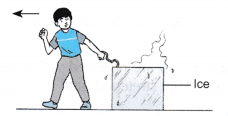
(a) If the force F = 160 N, calculate the acceleration of the ice.
(b) If the velocity of the ice changes from 0 to 8 m s-2 in 5 s, calculate the force, F.
Solution:
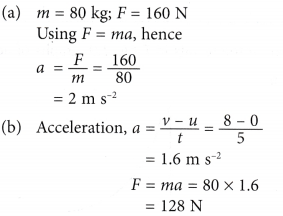
Example 2. A hawker pushes a tank of water with a horizontal force of 45 N. The total weight of the trolley and water tank is equal to 900 N.

Calculate
(a) the total frictional force if the hawker moves with uniform velocity of 5 m s-1,
(b) the acceleration of the hawker if the total frictional force is equal to 30 N.
Solution:

(C) Newton’s Third Law of Motion
Newton’s first law of motion gives a qualitative idea of force, while the second law provides us an idea to measure the force.
- Newton’s third law of motion states that ” if a body A exerts a force on the body B, the body B will also exert an equal and opposite force on A.”
- The force exerted by A on B is called action while the force exerted by B on A is called the reaction.
Newton’s third law is also stated as “to every action there is an equal and opposite reaction.” - Forces always occur in pairs.
- Action and reaction always act on different bodies.
- When you are practising arm wrestling with your friend, you will feel a force acting on you.
- Your friend will also be feeling a force acting on him. This is because while he is applying a force on you, you are also applying a force on him.
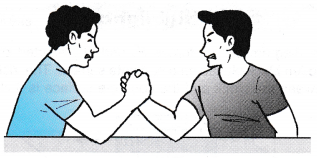
- This law is also known as the ‘action-reaction’ law. Hence, Newton’s third law of motion can be quoted as:
‘For every action, there is an equal but opposite reaction’. - A swimmer pushes the water backward with his hands and legs with a force, F, while the reaction force of the water, -F, pushes the swimmer forward.
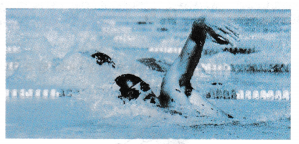
- Figure shows a fighter jet taking off from an airbase. The action of the exhaust gas rushing out from the nozzle with a force, F, causes a forward reaction force, -F, that moves the jet forward.

Applications of Newtons III law
- Recoil of a gun: When the bullet is fired from a gun, an equal and opposite force is applied on the gun, due to which the gun recoils in backward direction.
- Application in walking: While moving in forward direction we push the ground backwards that is the action. An equal and opposite force is applied by the ground on the man, thus the reaction due to which man moves forward.
- Rowing a boat in river: When we push the water backward with the help of oars (applying a force backward), an equal and opposite force acts on the boat. This is the reaction which moves the boat forward.
- Launching Rocket: In rocket, gases are produced in large amount. Due to internal combustion they come out and move backwards with an equal and opposite force which in turn acts on the rocket and moves it forward.
Example 1. The diagram shows forces F1, and F2 exerted on a wooden block placed on a concrete surface. The friction between the block and the concrete surface is 3 N.

Which pair of forces for F1, and F2 causes the wooden block to move with an acceleration?
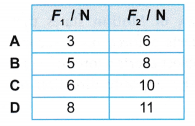
Answer: C
Acceleration occurs when there is an unbalanced force, where the net force is not zero.
Example 2. The diagram shows a car with a mass of 850 kg moving with an acceleration of 2 m s-2. There is a frictional force of 700 N acting on the car.

What is the force exerted by the engine of the car?
Answer:
Force exerted by engine = (850 x 2) + 700 = 2400 N
